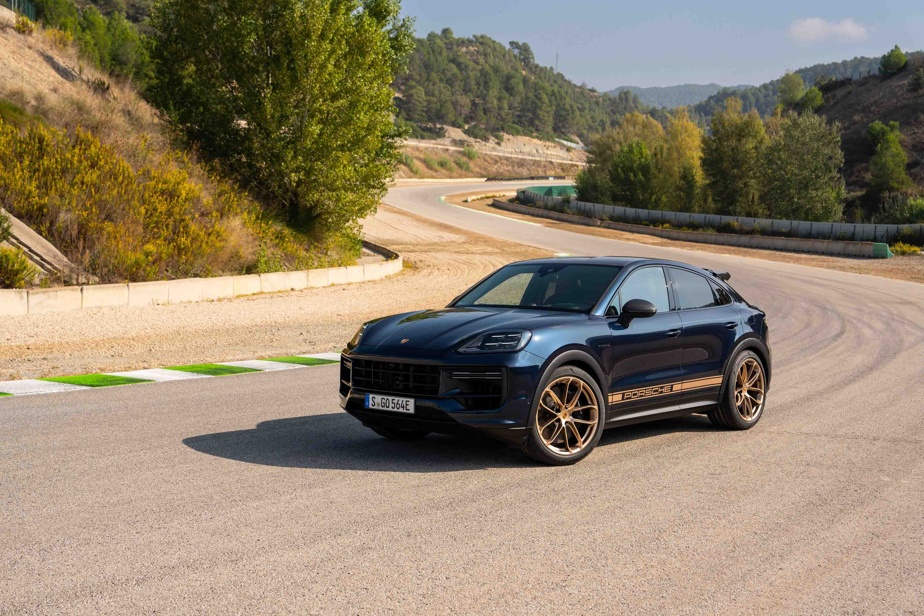(Barcelona) The Cayenne is to Porsche what the F-150 is to Ford: a money machine. Thanks to this utility vehicle, the German brand has freed itself from this tradition which until then confined it to producing low and slender sports cars. It also gave it the financial independence to successfully complete its electric transition.
Plug-in hybrids have a role to play in the automotive landscape. For how much longer ? On the one hand, their ecological performance depends on the user’s propensity to plug them in daily. On the other hand, over a long distance, the consumption of these models remains high due to the weight of the batteries. Arguments often invoked by organizations keen to end – and quickly – our dependence on fossil fuels.
Naturally, the automotive industry does not entirely share this opinion. In particular, they fear the cost associated with an energy transition that is too rapid. And these politicians who promise to repeal, in whole or in part, all regulations related to electric vehicles if they were elected. This is the case of a certain Donald Trump.
Porsche is keeping all its options open. The German brand is preparing to launch its second electric vehicle which will join the Macan range from next year (the current petrol models will be maintained). At the same time, Porsche is continuing its progress in the field of synthetic fuel and plug-in hybrids…
That brings us to the heart of the matter: the next-generation Cayenne E-Hybrid. Last step before the complete electrification of this utility vehicle planned for 2026, Porsche is taking advantage of its past experiences with the 918 (see the “Technical sheet” tab) and motor racing (Endurance and Formula E in particular). This is to better establish its technological and sporting image, of course.
With this in mind, it would not be surprising if the plug-in hybrid versions displace the 100% gasoline versions from the brand’s catalog in several regions of the world in the more or less long term. Porsche in any case gives the impression of being ready for this eventuality and now offers six mechanisms to drive the Cayenne, half of which now have a wire on the wheel. An additional V6 (paired with a more powerful electric motor) and a V8 are preparing to swell the ranks of the Cayenne.
The Porsche Cayenne offers three two-headed engines, but all use a single battery. And a big one this time: 25.2 kWh. This is more than that which powered the first generation of the Nissan Leaf (24 kWh) and the previous Cayenne hybrid (17.9 kWh). So less gasoline, more electricity, especially if the versions equipped with the V6 engine are favored. These have an electric range of almost 80 km, according to the optimistic European WLTP standard. The Canadian government has still not announced its figures, but in this test we were able to achieve almost 70 km with an S E-Hybrid version. In addition, it should be noted that the charging time has been reduced thanks to the integration of an 11 kW on-board charger.
Naturally, the Turbo E-Hybrid with the V8 engine is the one getting the most attention. This mechanism struck by lightning provides performance that meets what is expected of the brand. Just like the V6, this eight-cylinder engine underwent numerous modifications. The most notable concerns the abandonment of the twin scroll system. According to the engineers interviewed by La Presse, this return to a single volute makes it possible to reach the optimal engine temperature more quickly (fuel savings and reduction of greenhouse gases). Additionally, the engine responds more quickly at low and high revs, but falls a bit flat in between, reflected in a sudden lack of temperament.
Clearly, the Cayenne Turbo E-Hybrid violently tears up the asphalt at the start, calms down and then takes the bite back in its teeth. This results in discontinuous driving as if the thrust of the turbos were momentarily interrupted or as if they were affected by a response time that was too long. It’s not just the V8 that blows hot and cold. The braking system – revised to increase energy recovery – also requires some adaptation. Especially if the vehicle is equipped with expensive (purchase and maintenance) ceramic brakes, which are even more difficult to modulate.
Despite its elephantine weight, the Cayenne surprises both on the road and on the track. Yes, the track. Apart from the bumps during strong re-acceleration and the understeer that manifests itself, the Cayenne Turbo E-Hybrid has enough heart and legs to sustain a high pace. A real Porsche, but one that will be impossible for you to use on public roads. Therefore, wisdom dictates opting for the S E-Hybrid. Its 512 hp is more than enough.
La Presse will soon publish reviews of the following vehicles: BMW i5, Chevrolet Blazer EV, Honda Prologue, Lexus GX and Subaru Crosstrek. If you own one of these vehicles or are considering purchasing one, we would love to hear from you.
